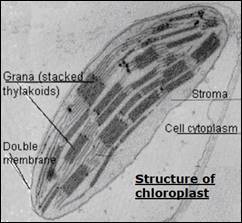Name the green dot-like structures in some cells observed by a student when a leaf peel was viewed under a microscope. What is this green colour due to?
The green dot-like structures in cells observed by a student when a leaf peel was viewed under the microscope were chloroplast.
Chloroplasts are very important in photosynthesis, the process by which light energy is converted to chemical energy, resulting in the production of oxygen and energy-rich organic compounds (as they convert the energy from sunlight into food).
Chloroplasts are distinguished from other types of plastids by their green colour, which results from the presence of two pigments, chlorophyll a and chlorophyll b. A function of those pigments is to absorb light energy. In plants, chloroplasts occur in all green tissues, though they are concentrated particularly in the parenchyma cells of the leaf mesophyll. The green colour in the leaf comes due to the presence of chlorophyll in chloroplasts.

Also the green colour appears to our eyes due to reflection because as sunlight falls (which is called white light and is composed of VIBGYOR) and we observe it, then all the colours get absorbed but green gets reflected back, and hence we see it as green.